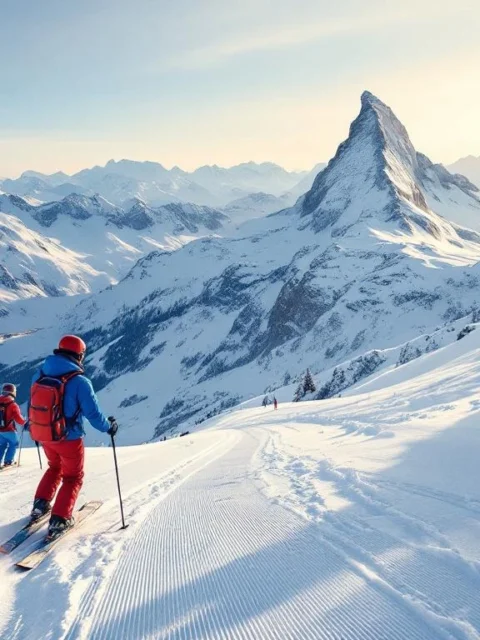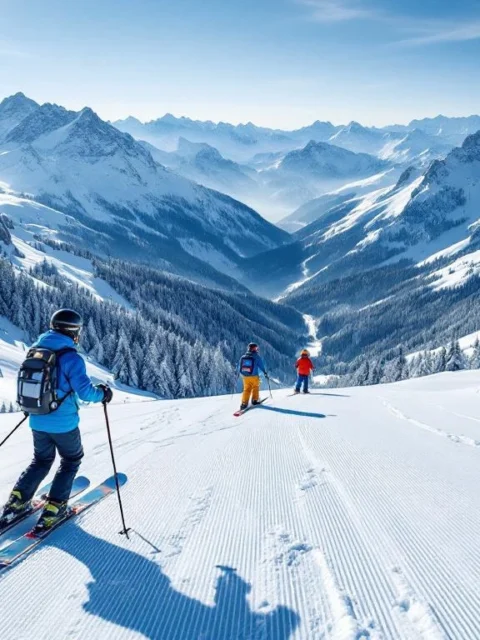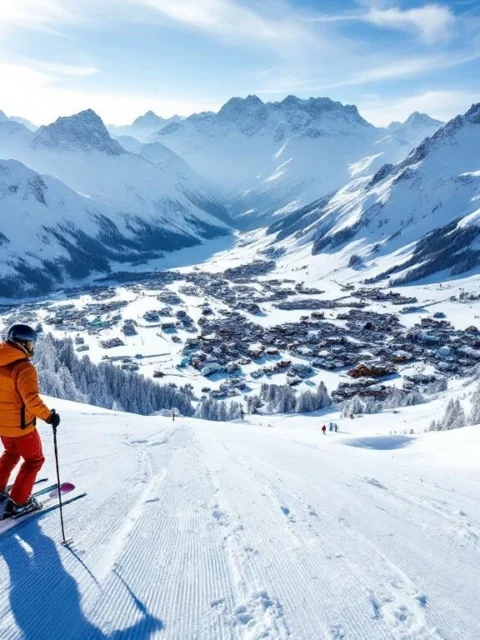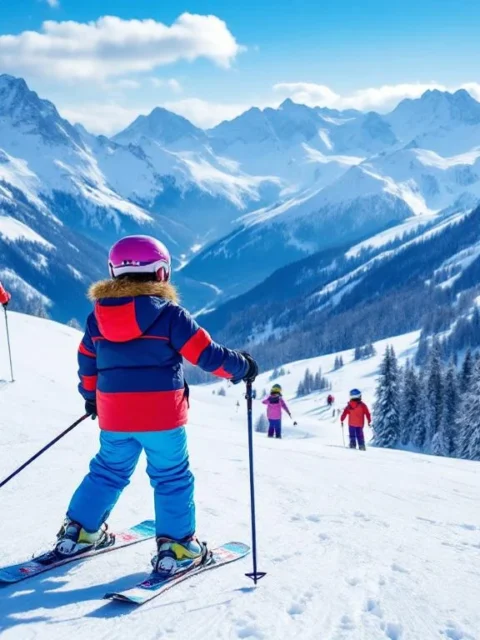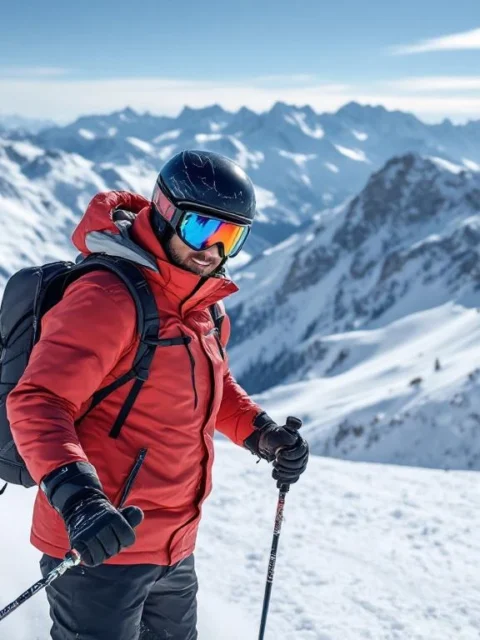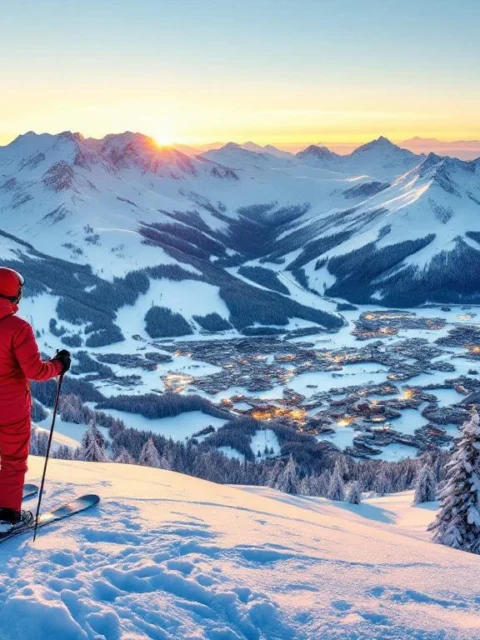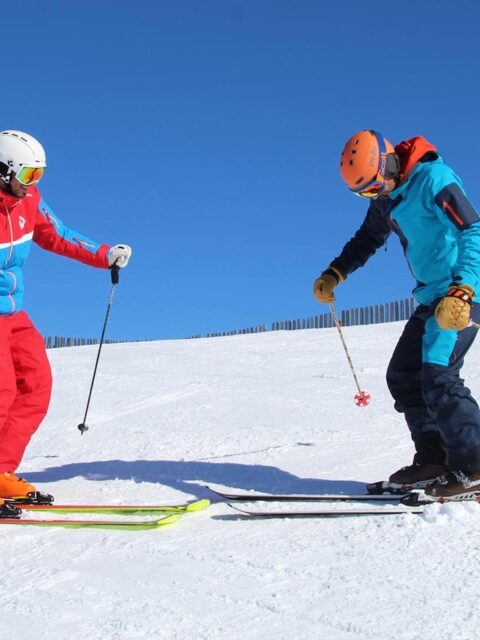How to Prepare for Black Diamond Slopes?
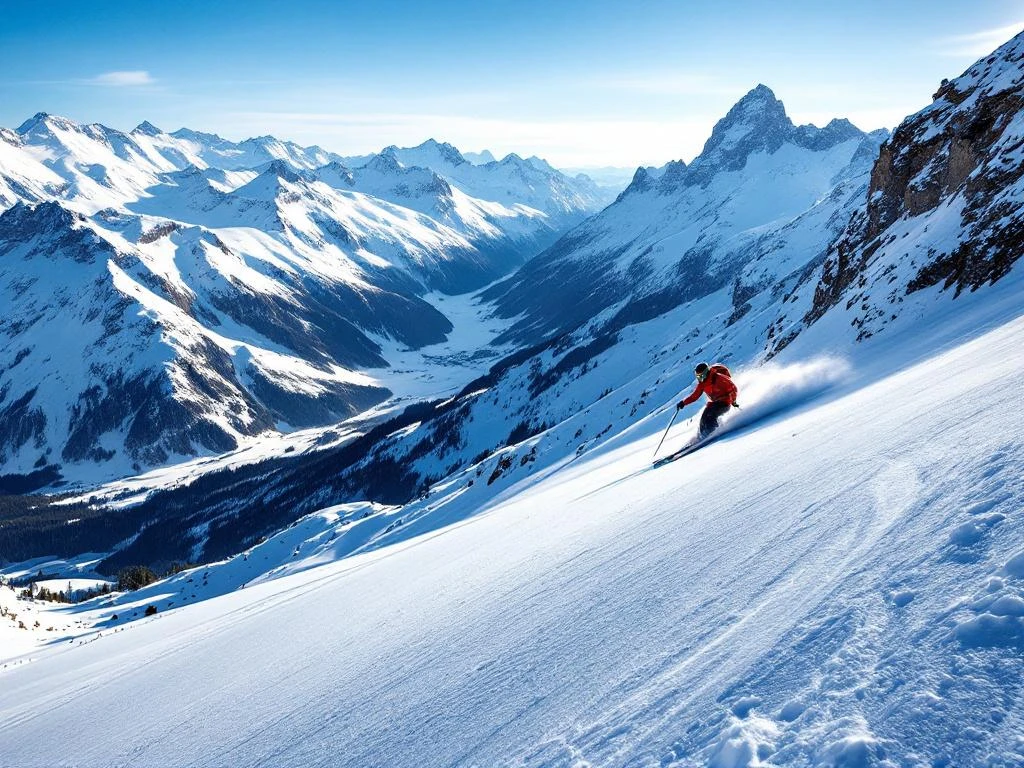
The black slopes beckon. Those steep descents with their challenging terrain catch your attention, but they also require thorough preparation. Whether you’re ready for your first black slope or want to improve your skills on challenging terrain, good preparation makes the difference between fearfully sliding down and confidently enjoying the descent. In this article, we share everything you need to know to conquer black slopes safely and with pleasure: from physical training and proper technique to mental preparation and the importance of appropriate equipment. Because with the right approach, that intimidating black diamond becomes your new playground!
Physical Preparation for Black Slopes
Do you find yourself standing at the top of a black slope with trembling legs? Then better physical preparation might be exactly what you need. Black slopes demand more from your body than blue or red descents. Your leg muscles, core, and endurance are put to an extra test.
Good leg strength is essential. Your legs need to absorb shocks for hours and keep you balanced on steep slopes. Therefore, regularly train your quadriceps, hamstrings, and calves. Squat exercises, lunges, and wall sits are perfect for preparing your skiing legs.
Your core stability largely determines how well you maintain balance on irregular terrain. Plank exercises and side planks strengthen your abdominal and back muscles. Vary these exercises by performing them on an unstable surface, such as a bosu ball.
Your endurance also plays a major role. On black slopes, you take fewer breaks – after all, you don’t want to stop on a steep incline. Cardio training such as running, cycling, or rowing helps you sustain longer descents without getting tired.
Start your training at least 6-8 weeks before your ski vacation. Training three times a week for 30 minutes already produces noticeable results. Build your training schedule gradually and don’t forget to add balance and coordination exercises. Brushing your teeth while standing on one leg or simple yoga exercises help improve your balance.
Which Ski Techniques Should You Master for Black Slopes?
The technical challenges on black slopes require specific skiing skills. Only with the right technique will you maintain control on steep and often irregular descents.
Short, quick turns are your best friend on black slopes. They help control your speed and quickly change direction on narrow or steep sections. Therefore, practice making short, parallel turns where you rapidly shift your weight from one ski to the other.
Your body position must be dynamic. Lean forward well with your shins against the front of your ski boots. This helps keep pressure on the front of your skis, which is important for control. Many beginners on black slopes make the mistake of leaning backward out of fear, causing them to lose control.
Carving on black slopes requires extra attention. Due to the steepness, your carving technique needs to be even more precise. Focus on tilting your skis by bending your ankles and knees, not by rotating your hips. The pressure on your outside ski should be greater than on flatter slopes.
Also learn to effectively make short turns in different situations. On icy sections, help your skis with an active up-and-down movement of your legs. In heavy snow, keep your legs more extended and use more rotation from your upper body.
A good pole plant supports your turning technique on steep slopes. Plant your pole further down and forward than you’re used to, so your body follows the right direction in the turn.
Don’t forget to properly regulate your speed by making regular short turns. On black slopes, constantly braking in a snowplow is usually not an option – it’s too tiring and less effective on steep sections.
Mental Preparation for Challenging Descents
Your technique and physical condition may be perfect, but without the right mindset, you won’t get far on black slopes. The mental aspect of skiing is often underestimated, while especially on black slopes, your thoughts can be your biggest obstacle or your strongest asset.
Controlling fear is the first step. A healthy dose of respect for the mountain is good, but paralyzing fear hinders your performance. Recognize the difference between realistic concerns (which keep you alert) and irrational fears. Visualize beforehand how you smoothly and controllably ski downhill. This programs your brain for success.
Build confidence step by step. Start with a simple black slope in good conditions. Each successful descent strengthens your confidence. Accept that you will sometimes fall – it’s part of the learning process. Learn to fall safely and get up again on steep slopes.
Concentration is an undervalued skill. On black slopes, you must be fully present, without distraction. Develop a ‘here-and-now’ focus by practicing mindfulness, for example. This helps you make quick decisions based on changing conditions.
Develop a strategy for difficult moments. What do you do if you suddenly doubt yourself halfway down a steep descent? Technique mantras can help: repeat key words like “forward,” “pressure on outside ski,” or “pole plant” to bring your focus back to the right technique.
Learn from every descent. Ask yourself after a run: what went well? What could be better? This reflection helps you grow mentally. Skiing with someone who is slightly better than you challenges you to push your boundaries while still remaining realistic.
Be patient with yourself. Progress on black slopes comes with falling and getting up. Each season you’ll get better, as long as you keep practicing and learning.
Advanced Ski Lessons: When and Why to Invest?
Even if you’ve been skiing for years, an advanced ski lesson can help you make the jump to black slopes. But when is it time to invest in professional instruction specifically for challenging descents?
The right time for an advanced ski lesson is when you’re comfortable on red slopes but hesitate at black ones. Or if you already ski black slopes but notice your techniques are inefficient, you get tired quickly, or you don’t feel completely confident.
A private lesson or a small group lesson for advanced skiers offers personal feedback that’s difficult to get on your own. An experienced ski instructor immediately sees where your technique can be improved and provides targeted exercises that perfectly match your level and learning style.
What can you expect from an advanced lesson? The focus is on refining your technique for steep descents, improving your carving on challenging terrain, and developing strategies for various snow conditions. A good instructor also works on your confidence and teaches you how to overcome mental blocks.
The cost of a lesson depends on various factors: the duration, private or group, the ski area, and the season. But see it as an investment: one targeted lesson can often give you more progress than a week of independent practice with incorrect habits.
The best time for lessons is at the beginning of your vacation, so you can spend the rest of the week practicing the new techniques. Also consider learning more about our different ski lesson options and which best suit your level and goals.
When booking a lesson, share your specific goals with your instructor. Do you want to get better at short turns on steep slopes? Do you want to learn how to handle icy conditions? The more specific you are, the more the lesson can be tailored to your needs.
Equipment and Materials for Black Slopes
The right equipment makes a world of difference on black slopes. Where you might get away with suboptimal gear on blue slopes, challenging terrain mercilessly reveals the weak points in your equipment.
Choosing the right skis is your first priority. For black slopes, all-mountain skis with a mid-wide waist (85-95mm) are often ideal. They offer the perfect balance between grip on hard surfaces and maneuverability. The length should be matched to your level – for advanced skiers usually up to your nose or slightly longer.
Pay attention to the stiffness of your skis. Skis that are too soft provide insufficient stability at high speed and in variable conditions. Skis that are too stiff are more difficult to control if your technique isn’t perfect. Most brands offer skis in different flex levels – choose a medium-stiff to stiff model depending on your weight and level.
Your bindings must be perfectly adjusted to your weight, height, and skiing style. Have them checked each season by a professional. On black slopes, reliable bindings that release at exactly the right moment during a fall are important for your safety.
Ski boots deserve extra attention. They are your direct connection to your skis. A well-fitting ski boot with the right flex (stiffness) gives you the control you need. For black slopes, usually a medium-stiff to stiff boot (flex 80-120 for women, 90-130 for men) is recommended.
Protective gear is not a sign of weakness but of sensible skiing. A helmet is obvious, but also consider back protection, especially if you’re going into the park or off-piste. Wrist guards can help during a fall and protect against the common “skier’s thumb.”
Don’t forget your clothing. Layers are important for temperature regulation. A good ski jacket and pants should be waterproof and breathable, but also provide freedom of movement. Choose gloves with good grip – you need control over your ski poles.
Well-maintained equipment makes skiing safer and more enjoyable. Have your skis regularly sharpened and waxed. Sharp edges are essential for grip on steep and icy sections of black slopes.
Conclusion
The jump to black slopes requires complete preparation: physical, technical, mental, and equipment-wise. By paying attention to all aspects we’ve discussed, you make the challenge manageable and gradually build the confidence to enjoy challenging descents with pleasure and control.
Know that every expert was once a beginner. Patience, practice, and the right guidance are your best friends on the path to mastering black slopes. At Ski-Pro, as fellow ski lovers, we understand both the challenge and the reward that black slopes offer. We’re happy to help you find the perfect ski lesson to take your skills to the next level, so you can soon descend that black diamond with a smile!
Frequently Asked Questions
How long does it take on average before you can safely descend black slopes?
This varies per person, but expect at least 3-4 ski weeks (or approximately 15-20 ski days) with regular practice on red slopes before transitioning to black slopes. Some skiers need more time, while others with a sports background progress faster. The most important thing is to only start on black slopes when you confidently descend red slopes and fully master basic skills such as parallel turns and speed control.
What should I do if I panic halfway down a black slope?
First stop in a safe spot where you're not in anyone's way. Take several deep breaths to lower your heart rate. Remind yourself of the proper technique: forward-leaning posture, weight on your outside ski, short turns. Divide the descent into small, manageable sections and focus on one section at a time. If it really isn't working, there's no shame in sliding down sideways or asking for help from a ski instructor or mountain rescue. Safety always comes first.
How do I specifically train for the bumps and irregularities typical of black slopes?
Practice on red slopes with many bumps or specifically look for 'mogul fields'. Start with slow trajectories over the bumps, focusing on flexibility in your knees to absorb the shocks. Strengthen your leg muscles at home with plyometric exercises such as box jumps and squat jumps. Balance boards or Bosu balls are excellent for improving your proprioception (body awareness), which is essential for navigating irregular terrain. Some ski areas also offer specific mogul slope lessons.
What weather conditions should I avoid during my first black slope experiences?
Avoid poor visibility (fog, heavy snowfall) because orientation on steep slopes becomes extra difficult. Icy conditions are also problematic for beginners on black slopes, as they require perfect edge control. Heavy, wet snow quickly tires your legs and limits your maneuverability. Plan your first black descents in good visibility, after recent snowfall when the slope has just been groomed, and ideally in the morning when you're still rested and the slopes are less crowded.
How do I choose the right first black slope to begin with?
Start with a 'light' black slope that is relatively short and runs onto a wider, less steep section. Ask local ski instructors for recommendations for beginning black-slope skiers. Study the piste map: black slopes that connect to red slopes are often more accessible. Explore the slope first by skiing alongside it or view it from below. Avoid slopes with narrow passages, cliffs, or many turns in your first attempts. In many ski areas, black slopes with one star are considered less challenging than those with two or three stars.
What are the most common technical mistakes when skiing on black slopes and how do I improve these?
The most common mistakes are leaning backward out of fear (improve by consciously pressing your shins against your ski boots), too little pressure on the outside ski (practice one-ski exercises to improve this feeling), making turns that are too long (practice short slaloms on red slopes), and incorrect viewing direction (always look where you want to go, not down or at your ski tips). Video analysis with a ski instructor can greatly help identify and correct these technical errors. One hour of specific coaching can bring more improvement than days of independent practice.
How do I optimally prepare my skis for black slopes?
Ensure recently sharpened edges with the right angles: usually 87-88 degrees on the side and 0.5-1 degree at the base for optimal grip on steep slopes. Have your skis waxed with a harder wax suitable for the local temperature. Check your bindings and have them readjusted to your current weight and ski level if necessary. For variable conditions on black slopes, all-mountain skis with a waist between 85-95mm are ideal; they offer both maneuverability and stability. Some skiers prefer slightly shorter skis on very steep or technical black slopes for extra maneuverability.


